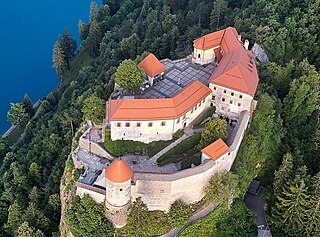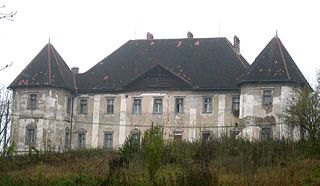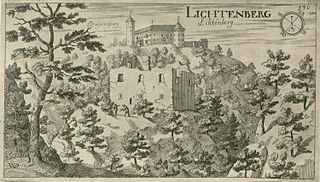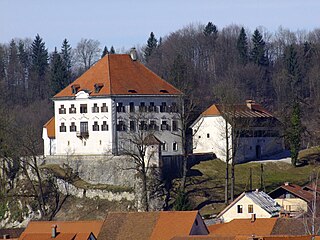
Brdo Castle near Kranj, usually simply Brdo Castle, is an estate and a mansion in the Slovenian region of Upper Carniola west of the village of Predoslje, City Municipality of Kranj, northwest of Ljubljana. It is the Slovenian government's main venue for diplomatic meetings and other government-sponsored events.

Bled Castle is a medieval castle built on a precipice above the city of Bled in Slovenia, overlooking Lake Bled. According to written sources, it is the oldest Slovenian castle and is currently one of the most visited tourist attractions in Slovenia. Nowadays, the castle is employed as a historical museum with a collection that represents the lake's history.

Tivoli Castle, originally called Podturn Manor, is a mansion in Ljubljana, the capital of Slovenia.

Ptuj Castle is a castle in Ptuj, Slovenia. It stands on a hill alongside the Drava River overlooking the town, and it is a prominent landmark.

Haloze is a geographical sub-region of Slovenia. It is in the northeast of the country, in the Styria region.

Strmol Castle is a castle located at the foot of Dvorjanski hrib near the villages of Češnjevek, Grad and Dvorje, in the Municipality of Cerklje na Gorenjskem, Slovenia. Named after its builders, the Strmol family, it is notable as one of the few castles in Slovenia to retain a Slovene name throughout its history. It is currently a guesthouse and conference site for the government of the Republic of Slovenia.

Bokalce Castle is a castle or mansion in Ljubljana, the capital of Slovenia. It stands at 312m above sea level.

Koprivnik Castle is a castle ruin above the village of Sveta Trojica, near Moravče in central Slovenia.

Olimje Castle is a 16th-century castle located in the settlement of Olimje, part of the Municipality of Podčetrtek in eastern Slovenia. It is currently a Franciscan monastery.

Lihtenberk Castle is a 13th-century castle ruin located in the Municipality of Šmartno pri Litiji in central Slovenia, directly adjacent to the later Bogenšperk Castle. It is best known for a minor association with the 17th-century historian Johann Weikhard von Valvasor, who owned the ruin and styled himself "von Lichtenberg."
Dolane is a settlement on the right bank of the Drava River in the Municipality of Cirkulane in the Haloze area of eastern Slovenia. The area is part of the traditional region of Styria. It is now included in the Drava Statistical Region.

Medija Castle is a castle ruin located in the southern part of the settlement of Podlipovica, west of Izlake, in the Municipality of Zagorje ob Savi, central-eastern Slovenia. The castle and its stables were destroyed by the Yugoslav Partisans during World War II. The castle chapel was later restored and now serves as a venue for plays, concerts, and other cultural events, as well as weddings.

Tkalec Manor is a baroque building situated next to the village of Štrigova in Međimurje County, northern Croatia.

Kolovrat is a settlement in the Municipality of Zagorje ob Savi in central Slovenia. The area is part of the traditional region of Upper Carniola. It is now included with the rest of the municipality in the Central Sava Statistical Region. The settlement includes the hamlets of Kal, Plavišnik, Prevalje, Spodnje Vrtače, Senčna Vas, and Strma Njiva.

The Volčji Potok Arboretum was opened to the public in 1952. It originally formed part of the Souvan family estate in 1885, which was taken over by the University of Ljubljana in 1952 and legally declared a place of cultural and natural heritage of national importance. Now independent of the university, it is the most visited botanical garden in Slovenia and in recent years has become well known for its spring flower shows. The arboretum is primarily a botanical garden for woody plants, the only one in Slovenia.

Zaprice Castle is a castle in Zaprice, now part of the town of Kamnik, Slovenia.

The Schrottenturn Manor is a manor in Stražišče, a neighborhood of the town of Kranj in northwestern Slovenia. It was built or owned in the 16th century by the Schrott family. In 1902, it was bought by the politician Oto von Detela and became known as the Detela Manor. Since World War II, it has been used as a residential building.

Ojstrica Castle was a castle above the settlement of Loke in the Municipality of Tabor in central Slovenia. Today only a ruin remains of the castle on a hill locally known as Stari Grad southwest of the settlement core.

Podsreda Castle is a fortress in Slovenia with in the Kozje region. It was formerly known as Hörberg or Herberch. The castle contains a small chapel and a defense tower.



















